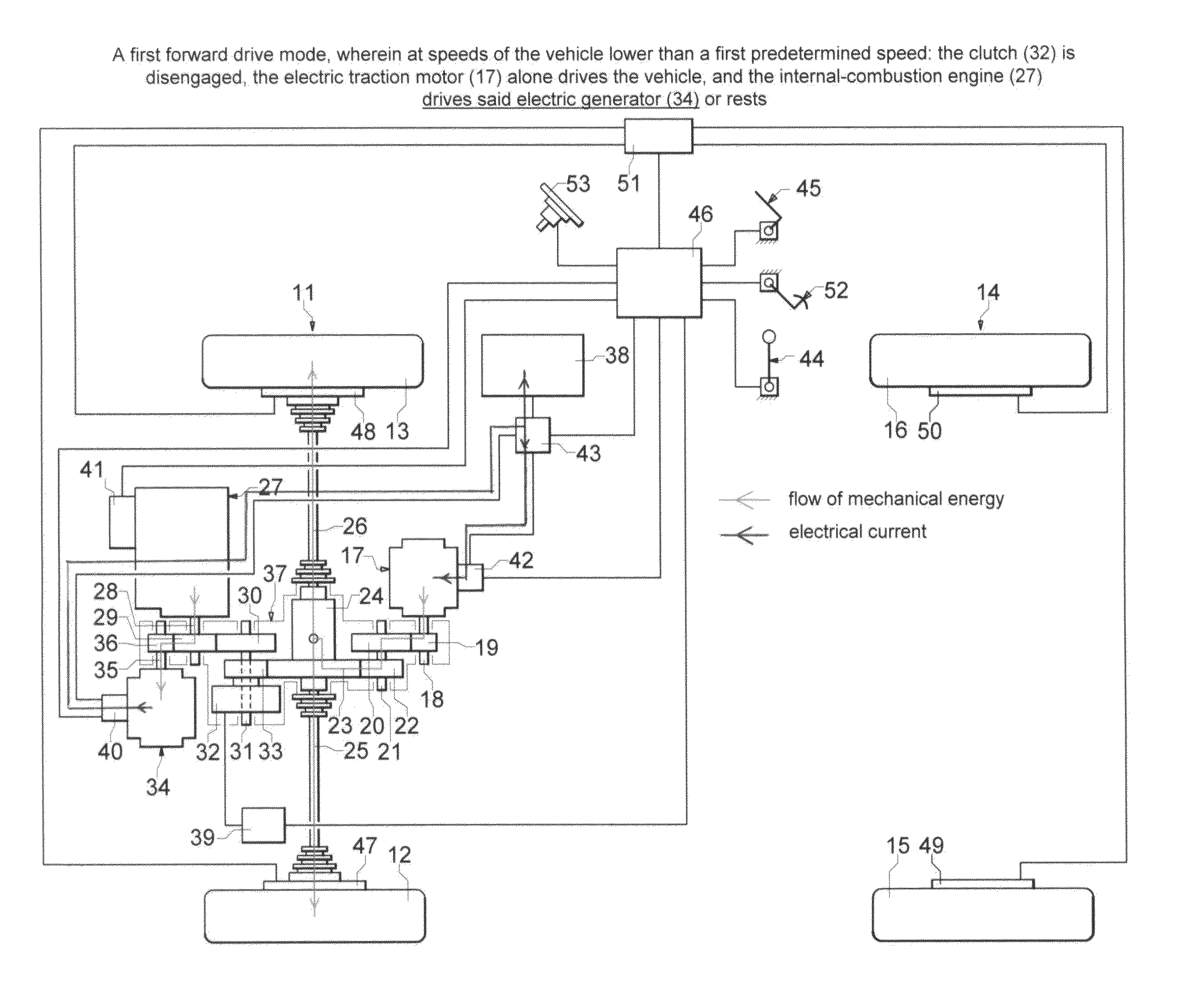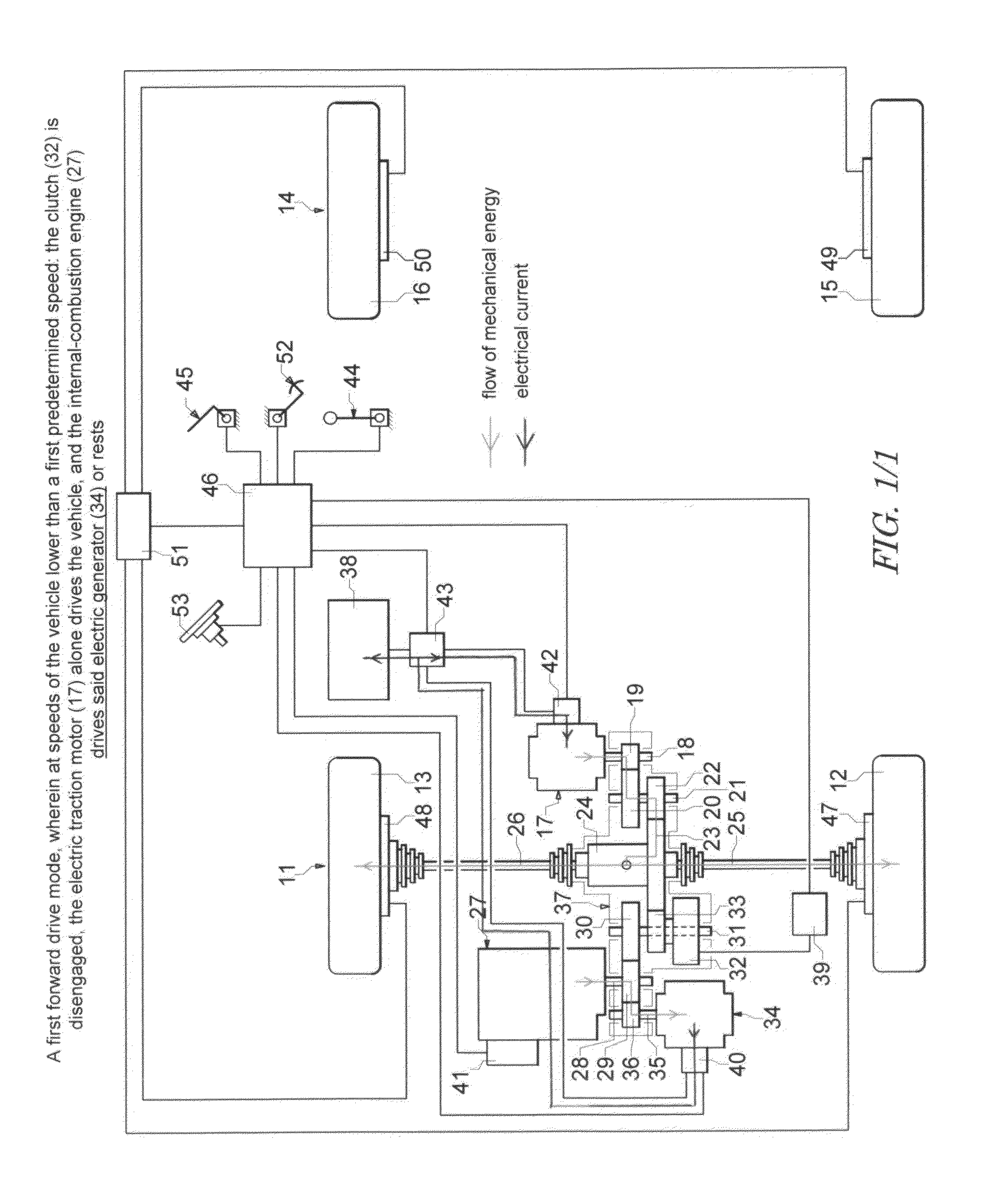Hybrid electric vehicle
a hybrid electric vehicle and electric motor technology, applied in the direction of automatic control systems, process and machine control, instruments, etc., can solve the problems of low fuel efficiency inability to run and produce useful power, and most unfavorable power-torque characteristics of internal combustion engines, so as to improve fuel efficiency and reduce the cost of the vehicle , simple and inexpensive operation control
- Summary
- Abstract
- Description
- Claims
- Application Information
AI Technical Summary
Benefits of technology
Problems solved by technology
Method used
Image
Examples
first embodiment
[0115]The mechanical components are shown very schematically as in views or cross sections unfolded into the plane of the drawing. The electrical components, controllers, and actuators are shown schematically as in a block diagram. The relationships between some of the components are shown with single lines regardless of how complicated these relationships might be in reality. For simplicity and clarity, no details irrelevant to the understanding of this invention are shown or described. For the same reason, some well known in the art components are mentioned but are not shown or are shown but are not described in detail. In the descriptions of the embodiments of this invention illustrated by FIG. 2 to FIG. 4, only what is different in comparison with the first embodiment illustrated by FIG. 1 is briefly described.
[0116]Referring to FIG. 1, a first axle 11 having two driving wheels 12, 13 and a second axle 14 having two free-rolling wheels 15, 16 are suspended to the frame of the ve...
third embodiment
[0173]In this third embodiment, the first mechanical drive train includes a planetary-gear type speed reducer 54. Hereinafter, for abbreviation of this description, the shorter term “planetary gear reducer” is used instead of the term “planetary-gear type speed reducer”. A sun gear 55 of the planetary gear reducer 54 is coupled with the output shaft 18 of the traction motor and is engaged with the planet gears 56 of the planetary gear reducer. A carrier 57 of the planet gears 56 is immobile. The planet gears are engaged with a ring gear 58 of the planetary gear reducer. The ring gear 58 is coupled with a clutch shaft 59. A bevel pinion gear 60 is coupled or integrated with the clutch shaft 59 and is engaged with a bevel crown gear 61 coupled with a differential 24 of the first axle 11. In this embodiment, it is assumed that the driving wheels 12, 13 are independently suspended to the frame of the vehicle and the mechanical energy is transmitted from the differential to the driving w...
fourth embodiment
[0179]In this fourth embodiment, the first mechanical drive train include said planetary gear reducer 54, as it is described with FIG. 3. Here, the clutch shaft 59 extends from the transmission enclosure 66 towards the first axle 11. A cardan shaft 67 connects the clutch shaft with an input shaft 68 of the first axle, which input shaft is coupled or integrated with said pinion gear 60. The cardan shaft 67 is actually an assembly of a shaft and two cardan joints. Such an embodiment, wherein the transmission of mechanical energy includes a cardan shaft, may be beneficial if bigger ground clearance under the traction motor is required.
[0180]In this fourth embodiment, the second mechanical drive train includes a sprocket wheel 69 coupled with the output shaft 28 of the engine 27, a clutch sprocket wheel 70 of the clutch 32, and a chain 71 engaged with said two sprocket wheels 69, 70 for transmitting mechanical energy between the engine and the clutch shaft 59. The function of the clutch...
PUM
 Login to View More
Login to View More Abstract
Description
Claims
Application Information
 Login to View More
Login to View More - R&D
- Intellectual Property
- Life Sciences
- Materials
- Tech Scout
- Unparalleled Data Quality
- Higher Quality Content
- 60% Fewer Hallucinations
Browse by: Latest US Patents, China's latest patents, Technical Efficacy Thesaurus, Application Domain, Technology Topic, Popular Technical Reports.
© 2025 PatSnap. All rights reserved.Legal|Privacy policy|Modern Slavery Act Transparency Statement|Sitemap|About US| Contact US: help@patsnap.com



